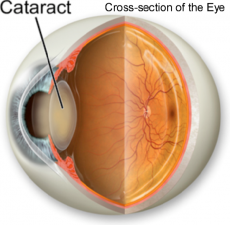
Ophthalmic Procedures: Cataract Surgery Instruments
Cataract is one of the common eye conditions that require invasive surgery. It is the increased opacity of the lens of the eyes. Common symptoms include seeing halos around lights, cloudy or blurred vision with sensitivity to glare and light. Cataracts are treated through ophthalmic surgery. The affected lens is removed and replaced with an artificial one, called an intraocular lens. This type of surgery uses a special set of cataract surgery instruments.
Cataract surgery requires a standard set of cataract surgical instruments due to the delicate nature of the eyes. General instruments may be too large and coarse for use in this surgical procedure, which may do more damage than good. Here a list of the common cataract surgery instruments:
- Castroviejo Caliper:
This used to measure size of the incision.
- Colibri forceps:
These fine and smooth forceps have special 0.12 1x2 teeth. They are used for holding cornea.
-
Capsulorhexis forceps:
These fine sharp-tipped forceps are used to make a continuous curvilinear incision on the anterior capsule of the lens.
- Capsulotomy forceps:
These forceps are use to create and incision in the anterior capsule of the lens during cataract surgery.
- Formed irrigating cystotome:
Irrigating cystotome is designed for capsulorhexis, intercapsular/endocapsular and can-opener capsulotomy techniques. Formed cystotome conforms to the convexity of the lens providing easier access to the anterior capsule. Reduces potential of corneal touch. Formed sharp tip cystotome for creating an opening into the anterior capsule, nucleus dislocating or other intraocular applications. Capsulorhexis cystotome has a special tip which provides more control of the flap when performing continuous curvilinear capsulotomies.
- Hydrodissectors:
A range of cannulas with tips designed to deliver fluids to facilitate the separation of the cortex from the nucleus and capsule.
- Viscoelastic cannulas:
For injecting viscoelastic to all meridians of the anterior chamber and to coat intraocular lens. This range of cannulas has smooth rounded tips for the safe introduction of viscoelastic.
- Diamond Knife:
The angled phaco knife is used this is a micro surgical knife used in making sclerocorneal tunnels in small incision type of cataract surgery. Can be used clear cornea blades and trapezoid self-diving blades.
- Side-port blade:
This is used in making a sclerocorneal side port or a secondary tunnel in small incision cataract surgery.
- Universal straight side-port knife:
This is used in making a sclerocorneal side port or a secondary tunnel in small incision cataract surgery.
- Knife for Micro Incision Coaxial Surgery (MICS):
Designed to make micro incision.
- Nucleus removing forceps:
This is an instrument used to force out the lens in extracapsular type of cataract extraction. Designed to remove fragments of the nucleus through a small incision. Ususally it has two rows of delicate teeth on jaws.
- Prechopper:
Prechopper is a special cross-action forceps for dividing a nucleus by the phaco prechop technique. Nowadays Combo Prechoppers are the most popular prechoppers, as they can be used for all kinds of cataract.
- Sinsky's hook:
This is an intraocular lens dialer. It has an angulated round hook with a handle used in inserting an intraocular lens.
- Irrigation/Aspiration handpieces
-
These special handpieces can be used for bimanual I/A (Irrigation handpiece and Aspiration handpiece) and Coaxial I/A (Irrigaton/Aspiration handpiece). Irrigation/Aspiration handpieces are used to maintain the intraocular pressure and to remove the residual cortex after phacoemulsification.
Cataract increases the opacity of the lenses of the eyes. The result is gradual and progressive impairment of vision. If left untreated, cataract can cause loss of vision. Cataract surgeries vary in types, depending on the patient’s condition and preferences. For each type, additional cataract surgery instruments are used to suit the needs.
